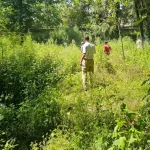As temperature dips, the incidence of Viral Respiratory Infections increases among children as harsh winters are favourable for respiratory viruses. Cold weather decreases the normal functioning of the respiratory tract. Overcrowding in families and schools makes transmission of viruses favourable. To know more about the Respiratory Infections and what people should do to keep the children at the safe side, Rising Kashmir’s senior health correspondent, M Peerzada is in a chat with Dr Suhail Naik, Assistant Professor New Children Hospital GMC Srinagar. Dr Naik talks about suggestions and preventive measures.
What are Viral Respiratory Infections?
Respiratory viral infections are infections of the respiratory tract and can affect both the upper and lower respiratory tract and sometimes cause a generalized systemic illness that we call as viral syndrome. There are different viruses namely influenza, parainfluenza, adeno, rhino, corno and respiratory syncytial viruses which have the propensity to infect the respiratory system.
Though these viral infections are usually generalized, some viruses can predominantly infect a specific area of the respiratory tract and subsequent illnesses are named accordingly like common cold, bronchiolitis, croup, or pneumonia depending on the predominant site of manifestation.
How does it affect children?
These viruses are spread by breathing in air droplets of the infected person who coughs, sneezes or even laughs less than 6 feet from your child and that is known as aerosol-borne infection. The virus can also be spread by touching something that the infected person has sneezed, or coughed and that we call finite borne.
The other important conditions that help in the viral spread are overcrowding, winters and not following cough-appropriate behaviour. First thing first, the survival and circulation of all respiratory viruses excluding Covid-19 increases during the winter months and due to intense cold the functioning and local immunity of the respiratory system falls.
Further windows are closed during winters and these all collectively increase the spread and frequency of viral respiratory infections during winter months.
What are the symptoms and red flags for parents?
The red flag signs in any respiratory tract infection are breathing difficulty, respiratory distress, poor feeding, lethargy, persistent vomiting, convulsions, dusky colour, SPO2 less than 92 percent and stridor in a calm child. These symptoms should alarm the parents and if present they must consult a nearby health facility so that the doctor will assess the severity of the illness and appropriate treatment is instituted.
What can parents do to protect their children from these infections?
Parents can’t control the bus or school environment. Fighting a war against any virus is dead impossible. But parents should understand that a healthy diet, lukewarm water, honey, kehwa, and multiple-layer clothing are some home remedies to decrease the frequency of viral infections.
Furthermore, it is the responsibility of parents to isolate their children and avoid sending them to school as soon as they notice a febrile catarrhal in their child. They should vaccinate their children with recommended flu vaccines yearly.
There are three things parents can do to protect their children. The first thing is to practice good hygiene. Cover your mouth and nose with a mask or tissue. Cover your mouth when you cough or sneeze. Cough in your elbow or sneeze in your elbow. Throw away used tissues immediately and wash your hands. Wash your hands regularly with soap or use a hand sanitiser. Avoid touching your eyes, nose and mouth.
The second thing is to keep up to date with children’s vaccinations, including for influenza and COVID-19. The third thing is breastfeeding, if your child is breastfeeding because breast milk is protective against these viruses in young infants.
In winter, respiratory diseases in children such as flu, and pneumonia account for 70% of diseases occurring in young children. So, how to prevent and treat respiratory diseases in children?
It is difficult to prevent them, though a balanced diet, exercise, some mentioned home remedies and yearly flu vaccination can prevent these infections to some extent and particularly at least severity is decreased.
The treatment of viral infections is supportive like paracetamol for fever, rest and hydration and some home remedies like Kashmiri kehwa, and honey. The most important thing about these infections is the patience of parents as these illnesses last for 7 to days. What we have observed is that to get rid of symptoms parents start doctor shopping and a lot of self-medication. In a week they change several doctors and the child gets rid of symptoms only when the disease completes its natural course.
Antibiotics are ineffective against viral pathogens, and prophylaxis against secondary bacterial infections is not recommended. Antibiotics should be given only when secondary bacterial infections develop. In patients with chronic lung disease, antibiotics may be given with less restriction. But unfortunately, antibiotics are overused and misused in these viral infections.
Parents must remember that it is dangerous to give Aspirin to patients aged ≤ 18 years with a suspected viral respiratory tract infection because Reye syndrome is a risk.
Secondly, they must understand that some patients continue to cough for weeks even months after the resolution of an upper respiratory infection; these symptoms may lessen with the use of an inhaled bronchodilator or corticosteroids.
What are symptoms of Viral Respiratory Infections?
When viruses invade cells of the respiratory tract, they trigger inflammation and the production of mucus. This situation leads to nasal congestion, a runny nose, scratchy throat, and cough, which may last up to 14 days.
Some children may continue to cough for weeks after the upper respiratory infection has resolved. Fever, with a temperature as high as 101 to 102° F (about 38.3 to 38.9° C), is common in young children or those with influenza. The child’s temperature may even rise to 104° F (40° C).
Other typical symptoms in children include decreased appetite, lethargy, and a general feeling of illness (malaise). Headaches and body aches develop, particularly with influenza. Infants and young children are usually not able to communicate their specific symptoms and just appear cranky and uncomfortable.
What are the complications of viral respiratory tract infections?
Usually, these are self-limiting diseases. Because newborn and young infants prefer to breathe through their nose, even moderate nasal congestion can create difficulty in breathing. Nasal congestion leads to feeding problems as well because infants cannot breathe while suckling from the breast or bottle. Because infants are unable to spit out mucus that they cough up, they often gag and choke.
The small airways of young children can be significantly narrowed by inflammation and mucus, making breathing difficult. Children breathe rapidly and may develop a high-pitched noise heard on breathing out (wheezing) or a similar noise heard on breathing in (stridor).
airway narrowing may cause children to gasp for breath and turn blue (cyanosis). Such airway problems are most common with infections caused by parainfluenza viruses, RSV, and human metapneumovirus infection. Children who develop breathing difficulty, increased breathing efforts or rate, dusky colour, or poor feeding should immediately consult a nearby health facility.
How can it be diagnosed?
Viral respiratory infections are typically diagnosed clinically based on symptoms and local epidemiology. For patient care, diagnosing the syndrome is usually sufficient; identification of a specific pathogen is rarely necessary. Doctors and parents recognize respiratory tract infections by their typical symptoms. Generally, otherwise healthy children with mild upper respiratory tract symptoms do not need to see a doctor unless they have trouble breathing, are not drinking, or have a fever for more than a day or two.
Diagnostic testing should typically be reserved for the few situations in which knowing the specific pathogen affects clinical management and outcome. Otherwise, the respiratory viral panel is costly and a report comes after a week, till then even severe illness stands resolved. Therefore tests are usually done for epidemiologic surveillance.
X-rays of the neck and chest are not recommended and may be taken in children who have difficulty breathing, stridor, or wheezing or if the doctor can hear congestion in the lungs. Blood tests and tests of respiratory secretions are rarely helpful.
What is the treatment of Viral Respiratory Infections?
Children with respiratory tract infections need additional rest and adequate fluid intake. Acetaminophen or non-steroidal anti-inflammatory drugs (NSAIDs), such as ibuprofen, can be given for fever and aches. In infants and young children, congestion may be relieved somewhat by using a cool-mist vaporizer to humidify the air.
What is the prevention of Viral Respiratory Infections?
The best preventive measure is practising good hygiene. An ill child and the people in the household should wash their hands frequently. In general, the more intimate physical contact (such as hugging, snuggling, or bed sharing) that takes place with an ill child, the greater the risk of spreading the infection to other family members.
Parents must balance this risk with the need to comfort an ill child. Children should stay home from school or childcare facilities until fever is gone and they feel well enough to attend.
Vaccination is particularly important for children and adults who have certain disorders, such as heart or lung disease, diabetes, kidney failure, and sickle cell disease.
Additionally, children who have a weakened immune system, including children with human immunodeficiency virus (HIV) infection and those undergoing chemotherapy, should receive the vaccine.
What is your message to parents, especially mothers this winter?
The first thing is a kitchen made balanced diet. Stop junk food and early isolation of children with respiratory symptoms. Vaccination for flu particularly in high-risk children aged less than 3 years, with asthma, or any chronic illness.





